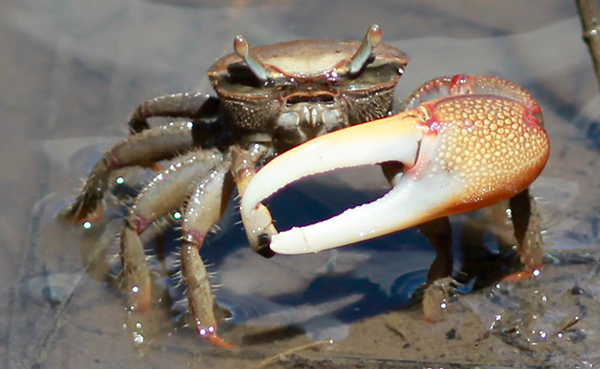THE NATURE CONSERVANCY’S BROWNSVILLE PRESERVE
In Brief: A fascinating “seaside” property held by a local family from 1652 until 1978, when it was acquired the The Nature Conservancy. A portion is open to the public along a 1.7-mile trail, a lovely place for a bike ride or walk at any season but most productive for birding during migration and in winter. One or two special events per year permit access to areas otherwise off limits.
Access: 11332 Brownsville Rd, Nassawadox, VA 23413. Open daily from 1/2 hour before sunrise to 1/2 hour after sunset, except during deer hunting season (1 October through 31 December), when hours are restricted to 9:00 a.m. to 3:00 p.m. No restroom facilities.
Website: https://www.nature.org/en-us/get-involved/how-to-help/places-we-protect/brownsville-preserve/
Additional Info: Virginia DGIF Birding Trail Site
EVERYTHING YOU NEED TO KNOW ABOUT BIRDING THE NATURE CONSERVANCY’S BROWNSVILLE PRESERVE
Fiddler Crab
Brownsville Preserve is a gem. Birders rarely take advantage of this property, which opens rather late in the day for people searching for migrant passerines during much of the fall, but it is not to be missed. The William B. Cummings Birding and Wildlife Trail passes through most of the habitats present on the 1250-acre former farm, including upland marsh, maritime forest, freshwater impoundments and marsh, and low salt marsh. Several brushy areas are interspersed. Bicyclists are welcome here. More information is available at https://www.nature.org/en-us/get-involved/how-to-help/places-we-protect/brownsville-preserve/
The small parking area near the farm headquarters can be productive for birding most of the years. In winter, Fox Sparrows’ sharp call notes and Hermit Thrushes’ low tchuck calls are often heard from the thick cover (they can be lured out with pishing), and in spring, brushy areas provide cover for scarce Northern Bobwhite, whose song can often bird hear in the morning in the distance. Passing along the trail (road), watch the high marsh for Swamp Sparrow and Sedge Wren in mid-autumn through winter, and watch for raptors and other diurnal migrants overhead, before passing through the Loblolly Pine forest, where Wild Turkey, woodpeckers, and flocks of migrants can often be found. As the forest opens up after about 1 mile, watch for stands of cattail reeds, which can hold Marsh Wrens at any time of year. In early winter, Blue-headed Vireos are occasionally seen in flocks led by Carolina Chickadee, kinglets, and Tufted Titmouse. A covey of Northern Bobwhite sometimes traverses this part of the trail, but it is normally seen farther along, in brushy areas. During very wet periods in late autumn or early winter, listen for the creaking call of Rusty Blackbird.
Eastern Phoebe, Photo: Robert W. Schamerhorn
The trail passes into a narrow gallery of forest, and opens into a section that has former irrigation ponds (now managed for wildlife) on the east side, and forest (with salt marsh beyond it) on the west side. The impounded freshwater areas can hold a fine variety of wrens, sparrows, herons, and shorebirds (even the occasional rail, such as Sora) at various times of year; when they are dry, a few sparrows are usually still here. At the sharp eastward bend in the trail, watch for a small track into the forest on the western side. This comes out quickly into saltmarsh, where there is a set of boards that takes the more intrepid birder (hopefully wearing Wellington-style knee-high boots or even chest waders) out into lower marsh comprised of Saltmarsh Cordgrass (Spartina alterniflora), with large stands of the more delicate Saltmeadow Hay (S. patens). Patient searching here in late fall and winter can turn up both Marsh and Sedge Wrens, Saltmarsh, Seaside, and Nelson’s Sparrows, Virginia Rail, and Wilson’s Snipe. High marsh areas that have Groundsel or other bushes often have Orange-crowned Warbler or occasionally a late, lingering Prairie Warbler.
Clapper Rail, Photo: Robert W. Schamerhorn
After returning from the marsh, one sees large areas of storm-killed pines (from Hurricane Isabel in 2003), which can hold a few woodpeckers and their cavities, sometimes used by Southern Flying Squirrel, whose raspy chirps can occasionally be heard at night (the local population of Delmarva Fox Squirrel has not been detected on the preserve since the late 1990s). Further down the trail, there are more impoundments, often used by waterfowl, ibis, and shorebirds. These impoundments should be approached slowly and quietly, so as not to flush the birds before they can be studied. Near the end of the trail, there is a marsh overlook at Phillips Creek and a raised platform that looks toward the marshes and a barrier island (Hog Island) in the great distance. These two spots can be superb for watching the afternoon and evening flights of shorebirds and herons, and Short-eared Owl is likely to be detected during October or November migration at dusk, when they emerge to migrate and to forage. American Bittern is also likely to be seen at this time of year and time of day.



